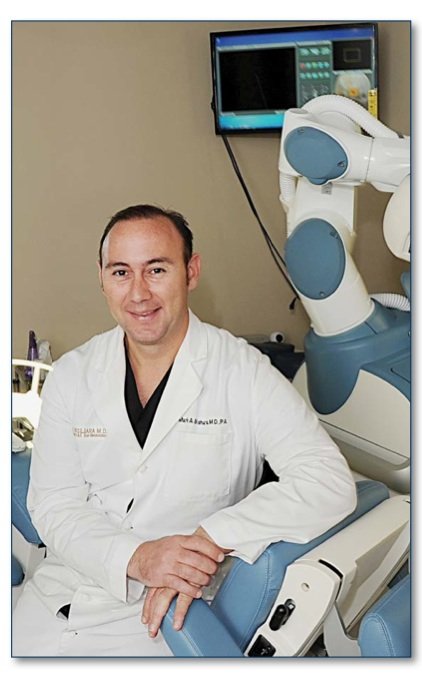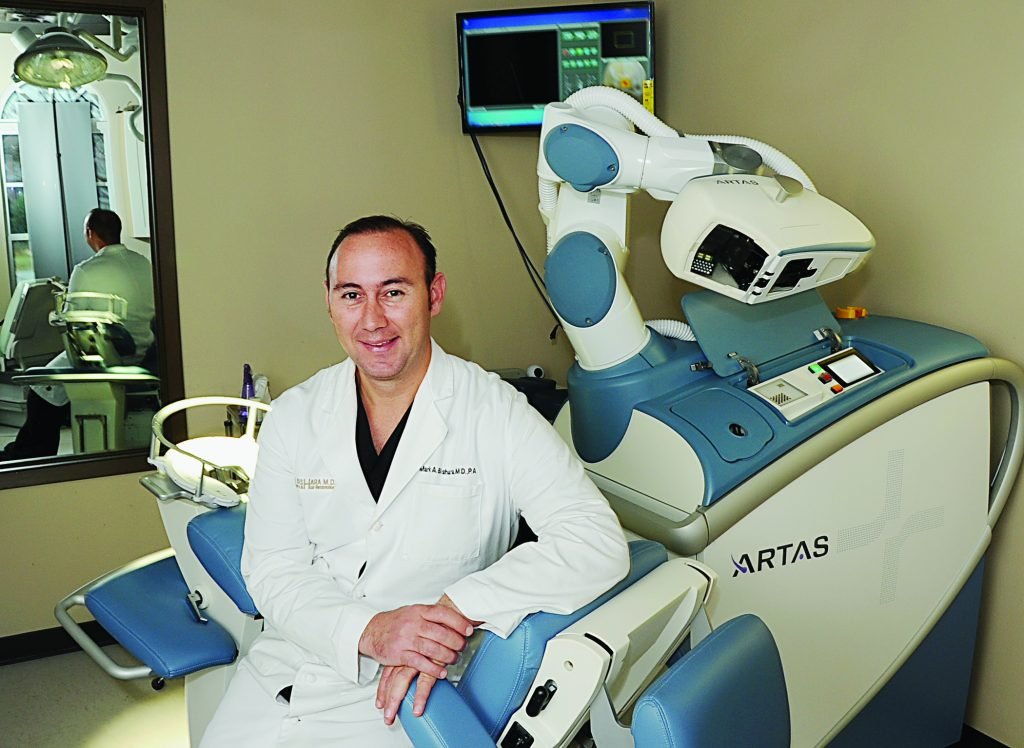
Dr. Bishara’s office locations in Mansfield and Southlake, TX have also added this important step in the Follicular Unit Extraction (FUE) procedure, a step that until now needed to be performed by hand. The goal of the new function is for the robot to automatically obtain the maximum number of donor hairs with the least amount of wounding and the greatest cosmetic benefit for the patient. Dr. Bishara is the only doctor in Texas that offers Graft Site Selection.
How Does it Work?
Using robotic graft selection, the hair restoration surgeon programs the ARTAS robot to harvest follicular units which contain two or more hairs by selectively skipping over the 1-hair units. Using its advanced optical guidance system, the robot orients itself to the scalp by way of special markings on a tensioner, a plastic frame-like device that is positioned on the donor area. The software then rapidly analyzes each graft and selects the appropriate ones for extraction. It then dissects these follicular units from the surrounding scalp tissue.
The Importance of Graft Selection in FUE
In FUE hair transplant procedures, the surgeon wants to harvest as much donor hair as possible while leaving the fewest number of wounds. To minimize the number of wounds, you would want to extract only the units that contain the largest amount of hair. However, smaller grafts of 1-hair are typically needed to create a natural-looking hairline and temples. By selecting and extracting larger grafts first, and then extracting smaller ones only as needed, surgeons can both minimize wounding and harvest an adequate number of follicular units of varying size so as to enhance the cosmetic benefit of the procedure. Smaller grafts can be generated by dividing the larger grafts without increasing the donor wounding.
This News is brought to you courtesy of Dr. Bishara and The Paragon Plastic Surgery & Med Spa


Posts
The follicular unit extraction (FUE) procedure consists of four steps: the separation of follicular units from the surrounding tissue, the removal of follicular units from the scalp, the creation of recipient sites, and the placement of follicular units into these sites. The first step is performed by the ARTAS robotic hair transplant system – the part of the FUE procedure requiring the greatest precision and that is most subject to human error.
Q: Is robotic FUE different in the number of follicular unit grafts one can extract compared to manual FUE?
A: We can extract (and transplant) the same number of follicular unit grafts robotically as we can manually.
There is generally less transection of the hair follicles with robotic FUE, since the method is more precise. This enables us to obtain follicular units with less trauma to the grafts.
Second, the robot is faster than the human surgeon, and much more consistent since, unlike the human surgeon, it never fatigues and the accuracy is maintained throughout the entire procedure.
Q: I am an African-American man with tight curly hair. Will the FUE robot be able to work on curly hair?
A: Yes, the ARTAS robot for FUE can be adapted for African-American hair when performing follicular unit extraction.
Q: How many different kinds of robotic devices are there?
A: There is only one, the robot called the ARTAS System for FUE, made by Restoration Robotics. The Neograft machine, occasionally confused with a robotic device, is actually a hand-held instrument that is not robotically controlled and lacks image-based tracking.
This Information is brought to you courtesy of Dr. Bishara and The Paragon Plastic Surgery & Med Spa
ARTAS System vs. Neograft?
When you look at the chart below, keep in mind that a great result depends largely upon the surgeon, his training, and the skilled people who support his surgical efforts. The ARTAS® robotic system is an invaluable, timesaving tool. The computer system provides your surgeon with 3-D images of your scalp. The images guide the staff to the best areas for harvesting hair follicles. Using the ARTAS® system provides your surgeon the time to precisely create your new, natural hairline.
Neograft is a device that uses a sharp punch to isolate grafts and a suction mechanism to extract them from the scalp. Both the sharp punch and suction are felt by many doctors to cause more injury to the follicles than the blunt dissection technique (used by the ARTAS robotic system for FUE). In addition, the Neograft is a hand-held device that, unlike the ARTAS, is not an image-guided robotic system and, therefore, lacks the precision of the latter technique.
This Information is brought to you courtesy of Dr. Mark Bishara and The Paragon Plastic Surgery and Med Spa in Mansfield and Southlake, TX
Please also visit our Facebook page at Paragon Plastic Surgery and Med Spa

A recent survey conducted by the International Society of Hair Restoration Surgery (ISHRS) showed that men and women around the world are seeking to correct hair loss while they’re younger rather than putting it off until later in life.
Since the ISHRS starting tracking data on hair restoration in 2004, the extrapolated worldwide volume of surgical hair restoration procedures performed from 2004 to 2012 increased 85 percent. What explains this tremendous increase in people seeking help for hair loss, even during tough economic times? We believe the unprecedented growth and increased popularity in hair restoration over the past decade can be directly attributed to the continual refinements and advances in this type of surgery – together with proven medical therapies – that produce natural-looking, permanent results.
Other key findings of the survey include:
- The number of women undergoing hair restoration surgery worldwide increased 20 percent from 2004 to 2012
- Patients aged 30 to 49 sought treatment for hair loss more than any other age group
- In 2012, ISHRS members chose John Mayer and Sofia Vergara as the celebrities with the best hair
The ARTAS System is a 21st-century technological innovation that was introduced into the hair treatment field in 2011 to treat male pattern baldness, or androgenetic alopecia. The system is sophisticated, utilizing computer assistance to harvest hair follicles during the actual process of hair replacement. ARTAS incorporates a number of elements in its operation, including an image-guided robotic arm and special imaging technologies that coordinate together for the purpose of implementing the “follicular unit extraction (FUE)” technique upon the recipient of the system.
In our practice, we offer patients some of the latest techniques in hair restoration surgery and proven medical treatments that can help men and women permanently restore thinning hair. If you are interested in hair restoration treatments, including ARTAS robotic hair transplants, and the latest treatment options, we would be happy to speak with you or invite you for a consult at our office. Please call our office at (817) 473-2120, visit our website at www.MarkBisharaMD.com, or click on the link below.
Get our Free Guide on Robotic Hair Restoration


Please also visit our website to learn more about ARTAS Robotic Hair Transplants System at www.MarkBisharaMD.com or call our office at (817) 473-2120




